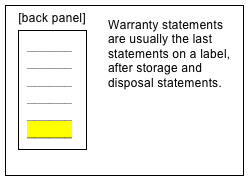Label Review Training: Module 3: Special Issues, Page 32
Section 7: What other label areas require special attention?
Warranty Statements
Most, if not all, pesticide labels contain some type of warranty disclaimer language. Warranty and disclaimer statements containing language intended to limit liability of the registrant or act as disclaimers or warranties for the product are generally covered by state law or may fall under the jurisdiction of the Federal Trade Commission. EPA will evaluate these statements to assess the extent to which the statements affect FIFRA label standards or EPA's implementing regulations.
There are four types of label language associated with disclaimers, warranties, and limitations of liability that EPA has found to be unacceptable. It is important to recognize that these statements must be assessed on a case-by-case basis. They are as follows:
- Overly broad statements negating or detracting from the directions for use or other label language (including precautionary statements and directions for use). For instance, if a warranty statement says it does not guarantee that the product will be effective or that it will not damage crops, this negates directions for use that explain how the product is to be used.
- Label language asserting that the buyer has accepted the manufacturer's statement of his/her rights (e.g., the manufacturer states that the buyer's rights are extremely limited: “all of these conditions are beyond the control of registrant X”). Because these statements are almost always incomplete (that is, they do not fully explain a buyer's rights in the state where purchased) and because they can mislead buyers into thinking that they have no legal remedy, they may constitute “misbranding” under FIFRA.
- Overly broad language implying that the buyer has no legal right to recover damages from manufacturer (e.g., “all such risks shall be assumed by the buyer”).
- Because experimental use permit (EUP) labels must be used in strict accordance with the EUP program, the warranty on EUP labels may not disclaim control over use. As with number 2 above, these statements can be considered misleading.
The reviewer should check the warranty statement for language that appears to negate or detract from Directions for Use or other language. The label reviewer should make sure that the disclaimer statement makes it clear that it is the registrant's or manufacturer's warranty disclaimer, by using such statements such as “To the extent consistent with applicable law, the manufacturer shall not be liable...” or “It is the manufacturer's intention that...”. This way it is clear that the language is coming from the registrant (and not EPA).
Resources
To determine warranty statements, see Chapter 12, Section 9 of the Label Review Manual.
Page 32 of 43
Previous Page Next Page
